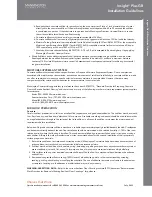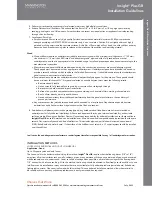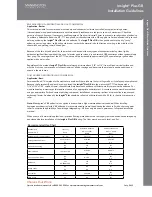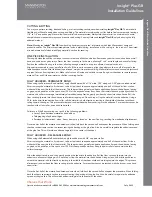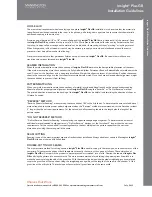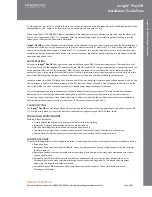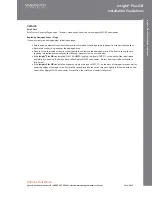
b. Randomly check concrete subfloor for porosity using the drop water test. Place a 1 inch diameter drop of water
directly onto the concrete subfloor. If the water droplet does not dissipate within 60 to 90 seconds the subfloor
is considered non-porous. If the substrate is too porous apply Mannington Premium Universal Primer to render
the surface suitable for adhesive and floor covering.
c. Concrete subfloors must have a minimum compressive strength of 3000 psi.
d. Concrete subfloors shall not consist of lightweight concrete or gypsum with less than 105 lbs. /cubic foot density.
e. Moisture Testing: Perform either the preferred In-situ Relative Humidity (RH) Test (ASTM F2170) or the acceptable
Moisture Vapor Emission Rate (MVER) Test (ASTM F1869). Acceptable moisture limits must not exceed 3lbs per
1000 square feet per 24 hours 1869 or 75% per 2170.
f. Alkalinity: Must test surface alkalinity (ASTM F710). A 7.0 to 9.0 pH is acceptable. Reduce higher pH by applying
Mannington
Premium
Universal
Primer.
6. Wood Subfloors and underlayment panels shall have the moisture content tested using a suitable wood pin meter.
Readings between the wood subfloor and underlayment pan should be within 3% and have a maximum moisture
content of 14% or less. Effective moisture control in basements and crawlspaces is essential for achieving a successful
long term installation.
MOISTURE SUPPRESSANT SYSTEM
Concrete subfloors that exceed adhesive specifications will require a Moisture Suppressant System. Due to complexities
associated with moisture vapor transmission, emissions and movement of soluble salts (alkalinity) in concrete subfloors, we do
not offer, recommend or warranty a specific solution for excess moisture in concrete slabs. However, there are many
companies that offer solutions with warranties for excess moisture in concrete slabs.
Mannington Commercial suggests that you reference the current ASTM F710, “Standard Practice for Preparing Concrete
Floors to Receive Resilient Flooring” and contact one or more of the following or other moisture suppressant system suppliers
for assistance:
Ardex (724) 203-5000 www.ardex.com
Koester American Corp. (757) 425-1206 www.koesterusa.com
Mapei (800) 426-2734 www.mapei.com
Uzin Ltd. (800) 505-4810 www.ufloorsystems.com
SUBFLOOR PREPARATION
Concrete
Careful subfloor preparation is vital for an excellent floor appearance and good sheet adhesion. The subfloor must be smooth,
firm, flat, clean, dry, and free from defects and fit for purpose. A suitable smoothing compound should be used to ensure that
no irregularities show through to the surface of the finished floor. In all cases, the subfloor must meet the moisture and pH
requirements before installation.
Below and On-grade concrete subfloors must have a suitable vapor retarder properly installed beneath the slab. Crawlspaces
and basements directly beneath the new floor installation should be maintained with a relative hu/- 10% of the room
relative humidity where the flooring is installed. This can be accomplished by proper ventilation and air circulation or using a
dehumidifier. Always follow other manufacturers’ written recommendations for the use and installation of their proprietary
surface preparation materials.
1. Record site conditions, test results and corrective action(s). Mannington Commercial requires written documentation of
site conditions, test results and corrective action(s) before processing claims.
2. Subfloor must be clean (free of dirt, sealers, curing, hardening or parting compounds or any substance that may stain or
prevent adhesion), smooth, flat, sound, fit for purpose, free of movement, excessive moisture and high alkalinity.
3. Slick surfaces such as power troweled concrete shall be profiled to allow for a mechanical bond between the adhesive
and
subfloor.
4. Remove existing resilient floor covering, 100% traces of old adhesives, paint or other contaminants by scraping,
sanding, grinding, shot blasting or scarifying the substrate. The use of adhesive removers or solvents in the abatement
or removal of existing or old adhesives is prohibited and may void any warranty.
WARNING: ASBESTOS & SILICA
- Refer to the current Resilient Floor Covering Institute (RFCI) document “Recommended
Work Practices for Removal of Existing Resilient Floor Coverings” for guidance.
Choices that Work.
Questions about warranties? call 800 241 2262 or visit www.manningtoncommercial.com
July, 2015
Insight
®
Plus GB
Installation Guidelines
Insight
®
Plus GB Instal
lat
ion Guidel
ines


